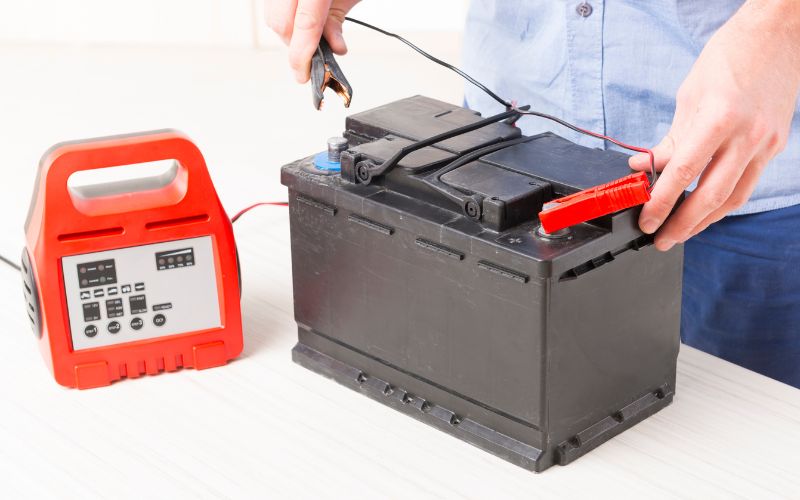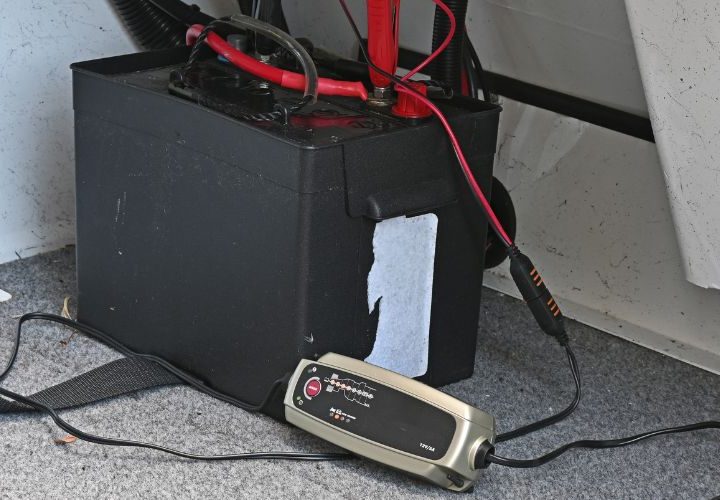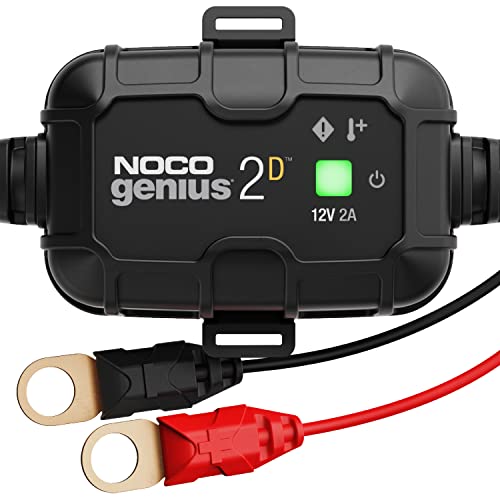You just bought a new marine battery, and you want to make sure you maintain it well to get the most life out of it.
Charging the battery correctly is a big part of keeping it in shape and preventing it from suffering an early death. With that in mind, you may be wondering: is it okay to use a trickle charger with your marine battery?
If so, how are you supposed to do it? How long should you leave the battery on the charger?
Keep reading! In this article, we’ll answer all of these questions and more!
Table of Contents
Can I Charge a Marine Battery With a Trickle Charger?

Generally speaking, it’s okay to use a trickle charger for your marine battery.
Trickle chargers provide a much lower rate of power flow into the battery, so it will take longer to reach a full charge; that said, it will also reduce your chances of the battery overheating during the charging process.
There are several things to keep in mind when using a trickle charger with your marine battery.
First, if you have a deep-cycle marine battery, you’ll want to use extreme care when charging it with a trickle charger.
Only use a trickle charger that you know is rated for deep cycle batteries, as standard trickle chargers may not provide a high enough charge rate and may cause damage from undercharging.
Most marine batteries are 12 volts, while many automotive batteries are 6 volts. If you are using a generic trickle charger or one designed for car batteries, it’s important to make sure it charges at the proper voltage for your battery.
It’s best to use a trickle charger specifically rated for marine batteries. We’ll talk about a couple of good options later on in this article.

In a perfect environment, trickle chargers usually put about 1.5 to 2 amps per hour back into your battery. In most real-world settings they operate at about 80 percent of this.
As mentioned, trickle chargers generally work well for marine batteries because they provide a slow, steady charge, thus reducing the chances of overheating. They also diminish your chances of damaging your battery by overcharging, especially those considered smart trickle chargers.
Smart chargers shut themselves off automatically when your battery has reached the appropriate charge. Nearly all new battery chargers, including trickle chargers, are smart chargers.
Even if you aren’t using a smart charger, it’s generally safe to leave your trickle charger hooked up to your battery for a couple of days, as long as you don’t forget about it entirely.
Standard trickle chargers will not shut themselves off, so they can damage your battery if you allow them to overcharge.
You may still be wondering, is it okay to use a trickle charger with all types of marine batteries? Let’s take a look.
1. Lead-Acid
Lead-acid batteries are some of the most commonly-used batteries because they are inexpensive, though they have limited applications on boats.
That said, if you do have a lead-acid marine battery, it is okay to use a trickle charger.
In fact, because lead-acid batteries are so common, most standard trickle chargers will be designed for use with them; this means you won’t have to look far to find a good charger.
- 【10-AMP QUICK CHARGER】12V 10-Amp and 24V 5-Amp 7-stage quick battery charger and maintainer, charging speed is much faster than 8-Amp or 5-Amp automatic chargers but harmless to the battery cycle...
- 【 SUMMER & HOLIDAY BATTERY TRICKLE CHARGER】Trickle charger is a low-current method of charging a battery to maintain its fully charged state, compensating for self-discharge. It's particularly...
Last update on 2025-07-11 at 08:58 / Affiliate links / Images from Amazon Product Advertising API
2. AGM
AGM batteries are far more commonly used for marine applications because they are more versatile and less prone to spilling and leaking than lead-acid batteries.
In most cases, it’s perfectly okay to charge your AGM battery with a trickle charger.
Trickle chargers work especially well for smaller batteries. If you have a larger battery, it may take a very long time for a trickle charger to return it to a full charge; that said, it will still work.
Make sure any trickle charger you use is rated for this type of battery.
3. Gel
Gel batteries are also frequently used for marine applications because they are highly weather resistant.
It is okay to use trickle chargers for all types of gel batteries. Although, it’s important to make sure you have a charger that’s rated for gel batteries, and it will take much longer to charge a larger or more deeply depleted battery.
- 🔋【Four Modes for Every Need】①Vehicle Mode: Max power (8.2A, 13.5V) for 85-95AH lead-acid batteries in your vehicle. ②AGM Battery Mode: Pro-level charging (8.2A, 13.5V) for 10-150AH AGM...
- 🔋【Supercharge Your Life with SUHU Battery Charger】Designed for 12V/24V lead-acid batteries, including AGM, EFB, GEL, SLA, and Flooded (WET) types, our SUHU car battery charger is a versatile...
Last update on 2025-07-11 at 08:58 / Affiliate links / Images from Amazon Product Advertising API
4. Lithium
Lithium batteries are a specialized choice that requires specific types of chargers. You may be able to use a trickle charger with your lithium battery, but your best bet is to use a charger recommended by the battery’s manufacturer.
How to Charge a Marine Battery With a Trickle Charger
It’s pretty easy to charge a marine battery with a trickle charger; you’ll follow the same basic steps as you would for using any other kind of charger, the process will simply take longer.
Follow the steps outlined below:
Step 1: Remove the Battery if Necessary
It’s not always necessary to remove the battery before charging; it will depend on the type of charger you have.
Most smart chargers can be used at the boat using solar power or by being plugged into an on-shore power source. As noted above, most modern chargers are smart chargers.
With older-style trickle chargers, you may need to remove the battery from the boat and take it to an area where you can keep an eye on it. Remember, you will have to manually remove it as soon as charging is complete.
Step 2: Hook Up the Charger Cables

To connect the charger to your battery, you’ll need to hook up the charging cables to the battery’s positive and negative terminals.
First, connect the positive side by clamping or screwing the red cable to the positive terminal. Then, the black cable will go to the negative terminal.
Depending on the type of charger you have, it may have alligator clips or ring connectors. If they are alligator clips, clamp them onto the battery terminals; if they are ring connectors, slip them over the terminals.
Step 3: Allow the Battery to Charge
This step takes the longest by far. You won’t want to wait around while your battery charges; depending on how deeply the battery is drained, recharging it with a trickle charger may take a day or more.
You may want to check on the charging progress from time to time. With smart chargers, you don’t have to disconnect them immediately; they will shut themselves off when a full charge is reached.

Old standard trickle chargers will not shut themselves off; instead, they will continue supplying charge even when the battery is at 100 percent.
This may not cause immediate issues, but eventually, the battery will be damaged from overcharging.
Step 4: Disconnect the Charger
Once your battery is fully charged, unplug the charger, then wait for 10 seconds before removing the charging cables.
Remove the black cable first to disconnect the negative side, then remove the red cable to disconnect the positive side.
Return your battery to the boat if necessary. Otherwise, you should be all set to get back out on the water.
How Long Should You Leave a Marine Battery on a Trickle Charger?

It’s impossible to say exactly how long to leave your battery on the trickle charger; every battery is different.
It is possible to estimate how long it might take to reach a full charge, but you will need to know the following:
- Charging amps: How many amps does your trickle charger put out while it is charging? This number should be listed on the packaging or in the user’s manual.
- Amp hours: A lot of batteries have their amp hour rating printed on the label. If you can’t find an amp hour rating, check the user’s manual, or look up your battery’s serial number online.
- Open voltage reading: You can get this number using a multimeter to check the direct current of the battery.
Plug these factors into this calculator for an estimate of how long it will take to charge your battery.
If you don’t have time or don’t want to do the math, simply leave the battery hooked up to the charger for as long as it takes to reach a full charge. This time will almost certainly be different for each battery.
Generally speaking, you will probably need to have the charger hooked up for 24 hours or less.
Some batteries may take up to 48 hours with a trickle charger, while others may only take 4 to 6 hours. Again, how long it takes your battery to charge will depend on various factors, including:
- How deeply the battery is discharged
- The amp output of the charger
- The size of the battery
- The age and condition of the battery
What is a Good Trickle Charger for Marine Batteries?
If you’re in the market for a trickle charger that you can use with your marine battery, consider giving the NOCO Genius 2D a try.
- MEET THE GENIUS2D — A direct-mount onboard battery charger for an under-the-hood battery charging. It's the all-in-one charging solution - battery charger, battery maintainer, trickle charger, plus...
- DO MORE WITH GENIUS — Designed for 12-volt lead-acid (AGM, Gel, SLA, VRLA) batteries, including flooded, maintenance-free, deep-cycle, marine and RV batteries.
Last update on 2025-07-11 at 18:57 / Affiliate links / Images from Amazon Product Advertising API
This onboard charger is more than just a trickle charger; it can also be used as a regular charger, float charger, maintainer, and desulfator. Whatever your onboard battery needs, this all-in-one charger should be able to handle them.
It can be used for 12-volt marine, deep cycle, car, and RV batteries. It will work for flooded lead-acid, AGM, and gel batteries (though it should not be used with lithium).
This smart charger will charge batteries as low as 1 volt, and the built-in thermal sensor adjusts the charging output based on ambient temperatures to prevent over- and undercharging.
Best of all, this charger works automatically according to the settings you select. It can be mounted on board and left hooked up to your battery all the time; it will provide charge when your battery needs it and turn itself off when the battery is fully charged.
Conclusion
You can use a trickle charger for your marine battery over a period of several hours or a couple of days.
Trickle chargers are a good choice for marine batteries because they reduce the risk of overheating and overcharging.
If you have a lead-acid, AGM, or gel battery, consider trying the NOCO Genius D2 smart charger reviewed above.
This versatile charger can be used for a number of different charging needs. Good luck and stay safe out there!

I created this site to help people – to help you – with your boat problems. Instead of helping one person at a time, I want this website to be the “one-stop-shop” for everyone’s boating concerns. Read more.




